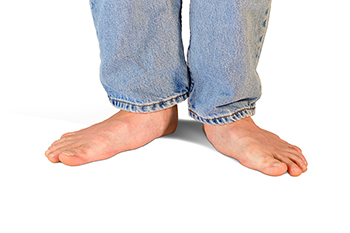
Pronation is simply how your foot hits the ground when you walk or run. When someone overpronates, it means that the foot rolls inward when taking a step. The outer edge of the heel generally hits the ground first, and then the foot rolls in toward the arch. This motion may put extra pressure on the muscles, tendons and ligaments. Overpronation can lead to a number of injuries, including ankle sprains, Achilles tendonitis, and plantar fasciitis. One way to determine whether or not you overpronate is to check out the bottom of your shoes. If the shoe is worn on the inside of the sole nearest the big toe, it may indicate overpronation. Next, stand in bare feet and look into a mirror to see if your feet are flat or have low arches. This is another indicator of overpronation. Symptoms of overpronation include heel or arch pain, flat feet, hammertoes, or pain in the knees, hips, or back. To be certain, it is a good idea to visit a podiatrist who can conduct a more formal examination and determine if orthotics can help to correct the condition.
If you have any concerns about your feet, contact one of our doctors from Kitsap Foot & Ankle Clinic. Our doctors can provide the care you need to keep you pain-free and on your feet.
Biomechanics in Podiatry
Podiatric biomechanics is a particular sector of specialty podiatry with licensed practitioners who are trained to diagnose and treat conditions affecting the foot, ankle and lower leg. Biomechanics deals with the forces that act against the body, causing an interference with the biological structures. It focuses on the movement of the ankle, the foot and the forces that interact with them.
A History of Biomechanics
- Biomechanics dates back to the BC era in Egypt where evidence of professional foot care has been recorded.
- In 1974, biomechanics gained a higher profile from the studies of Merton Root, who claimed that by changing or controlling the forces between the ankle and the foot, corrections or conditions could be implemented to gain strength and coordination in the area.
Modern technological improvements are based on past theories and therapeutic processes that provide a better understanding of podiatric concepts for biomechanics. Computers can provide accurate information about the forces and patterns of the feet and lower legs.
Understanding biomechanics of the feet can help improve and eliminate pain, stopping further stress to the foot.
If you have any questions please feel free to contact one of our offices located in Bremerton and Port Orchard, WA . We offer the newest diagnostic and treatment technologies for all your foot and ankle needs.
